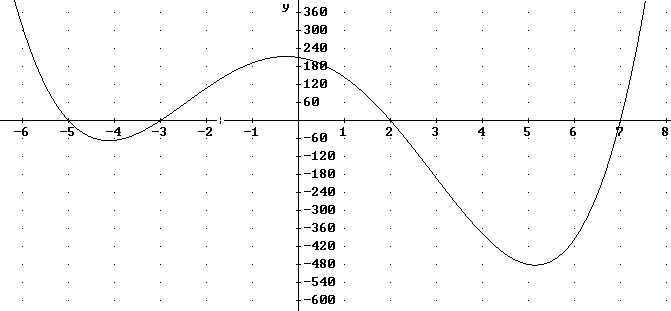
1117
http://www.vhcc.edu/dsmith/images/graph_series_1.htm
Construct the graph of y = p(x) = (x - 2) ( x + 3) * (x - 7) ( x + 5).
We know that the x intercepts must be at x = -5, -3, 2 and 7.
The y-intercept is at p(0) = -2 * 3 * -7 * 5 = 210.
At far left x is a large negative, which gives us the product of four large negatives, which is a large positive.
At far right x is a large positive, which gives us the product of four large positives, which is a large positive.
So we get the graph

Construct the graph of
We know that the x intercepts must be at x = -5, -3, 2 and 7.
The y-intercept is at p(0) = (-2)^2 * 3^3 * -7 * 5 = -3780.
At far left x is a large negative, so every linear factor is a large negative. This gives us the product of the square of a large negative, the cube of a large negative, and two other large negatives. This is the product of a total of 7 large negative numbers, which gives us a huge negative number.
At far right x is a large positive, which by similar reasoning gives us the product of seven large positives, which is a huge positive.
Our graph has to start out at a large negative and end up at a large positive, going through only the zeros we've listed (no other number can possibly give us zero, since none of the factors would be zero), and going through the y intercept.
Seems like we CAIN'T do it. We end up below the x axis having to get back to large positives, but we don't have another zero to go through.
Gotta think about this.
Think about what happens when x is close to 2.
We have (x-2)^2 ( x+3)^3 (x-7) (x+5). When x is close to 2, (x - 2) could be positive or negative depending on whether x is a little less than 2 or a little greater. However x+3 is close to 5, x - 7 is close to -2 and x + 5 is close to 7, and none of these values changes significantly as long as x stays close to 2.
So the product is close to (x-2)^2 * 5^3 * (-5) * 7 = -4377 so our function is close to
This is just our basic quadratic y = x^2, vertically stretched by factor 4377 and horizontally shifted 2 units.
Give the formula for a polynomial function which passes through the points (-3, 0), (2, 0) and (5, 0), having a y-intercept of 4.
Sketch graphs of f(x) = (x - 3) and g(x) = (x+ 2).
For the functions f(x) and g(x) of the preceding problem
For the functions f(x) and g(x) of the preceding problem